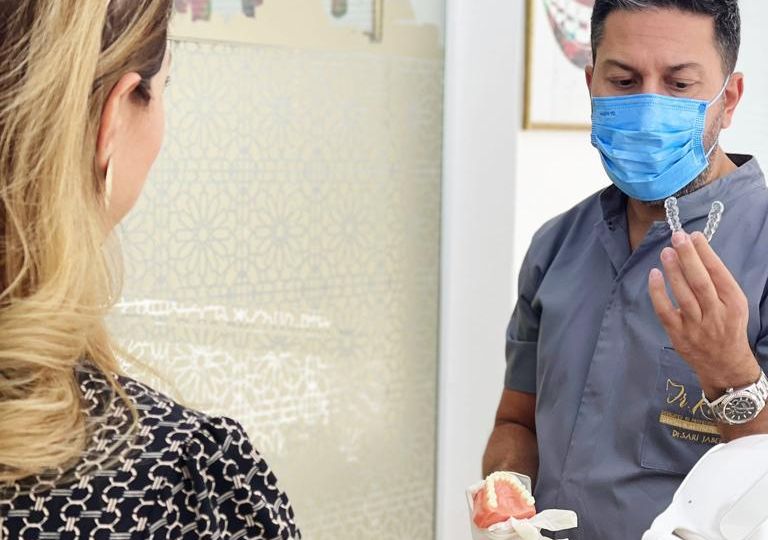Orthodontics and dento-facial orthopedics make up the specialty of dentistry which has as object of study the supervision, guidance of the growth and development of dento-facial structures, their pathology, as well as the therapy of dento-maxillary anomalies.
Orthodontic treatment is recommended because in the long run, untreated conditions can lead to speech defects, predisposition to tartar formation and thus tooth decay or digestive disorders.
Any orthodontic treatment starts with a consultation and treatment plan drawn up by the orthodontist. Depending on the situation at the level of the dental arches, the patient will wear an orthodontic appliance, either fixed or mobile.
Dental malocclusion is an abnormal relationship between the teeth of the two dental arches. The relationship between the upper and lower teeth is called dental occlusion.
In a normal occlusion, the upper teeth are positioned slightly in front of the lower teeth. Few people have perfect occlusion, but in severe cases, crowding of the teeth and especially a bad bite can cause problems other than aesthetic ones.
- crowded teeth are more difficult to clean; this increases the risk of caries at this level (especially interdental caries)
- severe malocclusion can put additional pressure on teeth, making them vulnerable to fracture or decay
- Severe malocclusions can create difficulties with speech, chewing and swallowing .
Why does malocclusion occur?
Malocclusion can be favoured by several factors:
- Disproportion between jaw and tooth size
A common cause of crowding is a disproportion between the size of the jaw and the size of the teeth. If the child’s jaw is too small, the teeth may erupt in a crowded manner. On the contrary, if there is too much space on the upper jaw or mandible, the teeth may erupt in spaced or abnormal positions.
- Following dental extractions
When a tooth is lost (permanently or temporarily), the nearby teeth tend to move into the newly available space, changing their alignment. This process can lead to both crowding of the teeth and the development of a malocclusion.
For this reason, the timing of the extraction of baby teeth must be chosen carefully. If a temporary tooth is extracted too quickly, the neighbouring teeth may “close” the gap that has formed, and when it erupts, the permanent tooth will not have enough space.
- Disproportion between the size of the jaw and mandible
If the upper jaw is much larger than the mandible, the upper teeth may erupt far in front of the lower teeth. This encourages the emergence of a “super-cluster”.
If the mandible is more voluminous, the lower teeth may erupt in front of the upper teeth leading to occlusion or reverse bite.
- Other causes
Other causes include finger sucking, incorrect pacifier use or mouth breathing. Some forms of malocclusion may also have a hereditary component.
Symptoms and signs
The most obvious signs of malocclusion are aesthetic and are due to crowding or crowding of the teeth or the appearance of an abnormal “bite” (e.g. reverse occlusion) which has important effects on the individual physiognomy.
Mild malocclusions produce no symptoms. Severe conditions may cause discomfort when biting or chewing, slurred speech or difficulty swallowing. Because they can hinder proper oral hygiene, malocclusion can lead to caries or gum disease.
Treatment of malocclusion
Malocclusion treatment is carried out by the orthodontist.
- Treatment of malocclusions in children
Teeth crowding is a fairly common disorder in children. Before treatment begins, the orthodontist will conduct a thorough examination that will include:
- questions about the child’s health
- examination of teeth and oral tissues
- dental X-rays and pictures of the patient’s face and teeth
- making a dental impression in order to make a study model.
Following these examinations, the specialist will be able to establish a correct diagnosis followed by appropriate treatment.
Malocclusion is then treated with braces which are made of metal wires attached to the teeth. Constant gentle pressure on the teeth helps them return to their correct position.
If the malocclusion takes the form of an occlusal disorder, appliances will be indicated to help the mandible reposition itself correctly in relation to the upper jaw. Treatment of malocclusions during the growing period is most effective because repositioning the teeth and jaws is much easier.
- Treatment of malocclusions in adults
The principle of the treatment is the same, but the duration is usually longer. In the case of cramped conditions, fixed appliances are recommended and should be kept for a minimum of 2 years. Braces can make brushing difficult, so extra care is needed when performing oral hygiene.
Orthodontic appliances for jaw repositioning are not effective in adults; if jaw repositioning is needed, surgery is the only method.
After the treatment is completed, the teeth tend to return to their original position; for this reason, a retainer is used, which must be worn for a period that can vary from several months to several years.
Bottom line:
- treatment of malocclusions can take 2 years or more depending on the clinical case
- orthodontic treatment takes longer in adults than in children
- at the end of the treatment, a restraint will be made to be worn for up to several years
it is advisable to take your children regularly to the orthodontist from the age of 2. In this way, any disorder will be diagnosed early and treatment will be much simpler.


